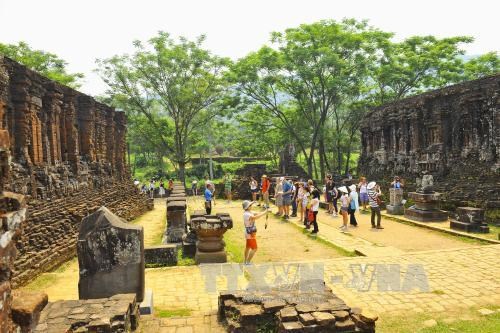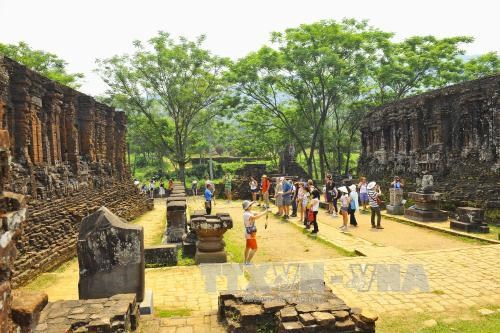
More than 1,000 artifacts uncovered during the excavation and restoration of towers in the world heritage site of My Son sanctuary in the central province of Quang Nam have been digitalised thanks to the assistance of experts from Italy and India.

Visitors at the My Son Sanctuary (Source: VNA)
Italian experts have worked with
technicians from the management board of the heritage site to digitalise the
artifacts, including statues, bricks and other objects used for the
construction of towers.
Head of the management board Phan Ho
said the digitalisation is one of the notable outcomes of international
cooperation efforts to protect the world heritage site.
Apart from the assistance of the Italian Government, experts from India have
been providing support to upgrade the towers, during which they discovered an
underground road and many valuable objects, he added.
All newly-found artifacts will be digitalised to make it easier for
preservation and restoration, he said.
My Son Sanctuary is located in a hilly landscape in Duy Phu commune, Duy Xuyen
district, about 70km southwest of central Da Nang city and 40km from Hoi An
city – another UNESCO heritage site in Quang Nam.
It comprises eight groups of 71 monuments built throughout the 7th -13th
centuries. The first construction of My Son dated back to the 4th century
under the reign of Bhadravarman for the worship of God Shiva-Bhadresvara. But
later on, the temple was destroyed.
At the beginning of the 7th century, King Sambhuvarman had it rebuilt and
rebaptised Sambhu-Bhadresvara. Each new monarch came to My Son after his
accession to the throne for the ceremony of purification and to present
offerings and erect new monuments, which explains why My Son is the only place
where Cham art flourished without interruption from the 7th to 13th century.
Source: VNA
With an increasingly vibrant and widespread emulation movement aimed at building cultured residential areas and cultured families, Yen Thuy District has been making steady progress toward improving both the material and spiritual well-being of its people, while fostering a civilized, prosperous, beautiful, and progressive community.
Once lacking recreational spaces and community facilities, Residential Group 2 in Quynh Lam Ward (Hoa Binh City) has recently received attention for the construction of a new, spacious, and fully equipped cultural house. The project followed the model of state support combined with public contributions in both labor and funding.
The "All people unite to build cultural life" movement, which has been effectively integrated with Kim Boi district’s socio-economic development goals, is fostering a lively spirit of emulation across local residential areas, hamlets, villages, public agencies, and enterprises. In addition, through the initiative, traditional cultural values are being preserved and promoted, while community solidarity and mutual support in poverty reduction and economic development are being strengthened.
A working delegation of the Hoa Binh provincial People’s Committee led by its Permanent Vice Chairman Nguyen Van Toan on June 11 inspected the progress of a project to build the Mo Muong Cultural Heritage Conservation Space linked to tourism services in Hop Phong commune, Cao Phong district.
Born and growing in the heroic land of Muong Dong, Dinh Thi Kieu Dung, a resident in Bo town of Kim Boi district, in her childhood was nurtured by the sweet lullabies of her grandmother and mother. These melodies deeply imprinted on her soul, becoming an inseparable part of her love for her ethnic group's culture. For over 20 years, this love for her hometown has driven Dung to research, collect, and pass down the cultural values of the Muong people to future generations.
In the final days of May, the Ethnic Art Troupe of Hoa Binh Province organized performances to serve the people in remote, mountainous, and particularly disadvantaged areas within the province. These were not just ordinary artistic shows, but they were the meaningful journeys aimed at spreading cultural values, enhancing the spiritual life of the people and contributing to the preservation of ethnic minority cultural identities.



